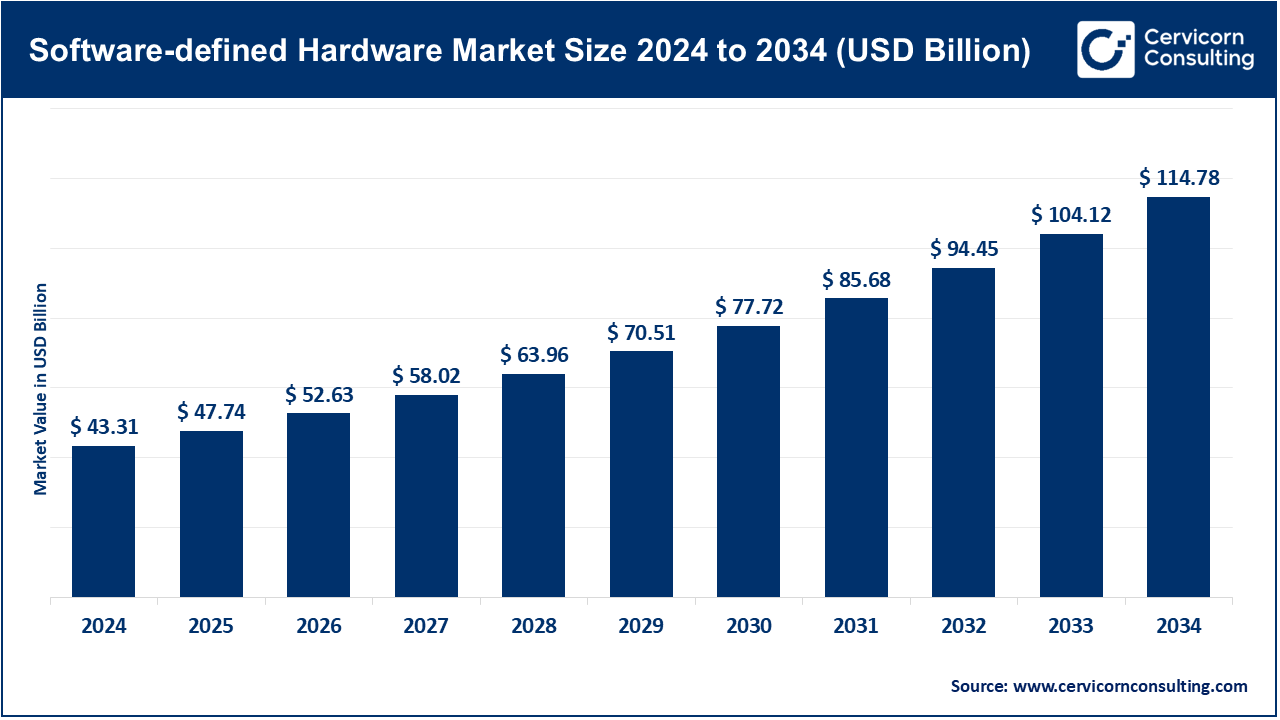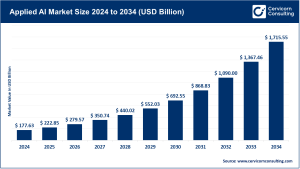Software-defined Hardware Market Overview
The global software-defined hardware market reached a valuation of USD 43.31 billion in 2024 and is forecasted to expand to USD 114.78 billion by 2034, registering a CAGR of 10.24% between 2025 and 2034. Unlike conventional fixed-function systems, SDH introduces a transformative approach by enabling programmable, flexible computing through FPGAs, ASICs, CPUs, and GPUs. This adaptability is fueling adoption in key sectors such as data centers, telecommunications, autonomous vehicles, and aerospace, particularly as AI and edge computing workloads demand real-time, reconfigurable hardware solutions.
Key Market Trends
1. Platform Consolidation and Standardization
The market is shifting toward fewer but more dominant ecosystems, resembling the mobile OS landscape. By 2028, it is anticipated that three to five software-defined vehicle platforms will hold global leadership, fostering interoperability, minimizing fragmentation, and driving supplier partnerships.
2. Cross-Industry SD Integration
Beyond IT, SDH is being embraced in networking, storage, industrial automation, and manufacturing. For example, Dell Technologies’ 2025 software-defined data center solutions highlight how these systems simplify infrastructure management and lower reliance on traditional hardware.
3. AI-Enhanced Hardware Configuration and Testing
Artificial intelligence is transforming SDH design, verification, and configuration. In January 2024, Siemens Digital Industries Software introduced AI-driven embedded platforms to streamline large-scale SDH testing, reducing both time and errors.
4. Expansion of Cloud-Based Deployments
Cloud-driven SDH offerings are gaining momentum thanks to their scalability and cost efficiency. Leading platforms such as AWS, Azure, and Google Cloud are supporting hybrid models that encourage enterprise and industrial adoption.
5. Integration into Automotive and Edge Computing
SDH is increasingly pivotal in autonomous vehicles and extended-range electric vehicles (EREVs). By supporting ADAS, domain controllers, and in-vehicle AI systems, SDH ensures responsiveness and real-time adaptability.
Market Drivers
-
Rising Demand for Flexible Hardware
Enterprises are prioritizing hardware that can adapt as software evolves. Data centers, in particular, are deploying SDH to meet growing needs in AI, high-performance computing, and storage. -
Advances in Processor Technologies
The integration of AI-ready processors, GPUs, and FPGAs enables rapid reconfiguration, boosting adoption across networking, industrial, and automotive markets. -
Government and Industry Support
Public and private initiatives are accelerating AI-enabled infrastructure and edge computing development. In 2024, North America contributed 38.2% of global revenue, reflecting substantial support and early adoption. -
Cost-Efficient Deployment Models
Hybrid and cloud-native SDH systems lower upfront costs, offering scalability for SMEs as well as large enterprises.
Impact of Trends and Drivers
-
By Industry: IT & telecom led with 36.7% market share in 2024, supported by growing AI-ready infrastructure and network upgrades. Automotive applications are quickly scaling with the deployment of EREV technologies.
-
By Region: North America remains the largest market, while Asia-Pacific emerges as the fastest-growing, driven by digitalization, smart infrastructure, and rising AI adoption.
-
By Application: Data centers dominate the market, representing 37.4% of global revenue in 2024, as demand surges for compute-intensive and storage-heavy solutions.
Challenges & Opportunities
Challenges: Technical integration complexity, thermal/power constraints, and the high upfront costs of programmable systems remain barriers.
Opportunities: Rapid expansion in EREVs, edge AI, cloud-native deployments, and industry-wide standardization present long-term growth avenues for vendors.
Future Outlook
The software-defined hardware market is projected to witness steady expansion, underpinned by AI-driven reconfiguration, automotive SDH adoption, and cloud-native deployments. By 2034, SDH will become a foundational technology for digital transformation across industries, reshaping the way hardware and software converge.

